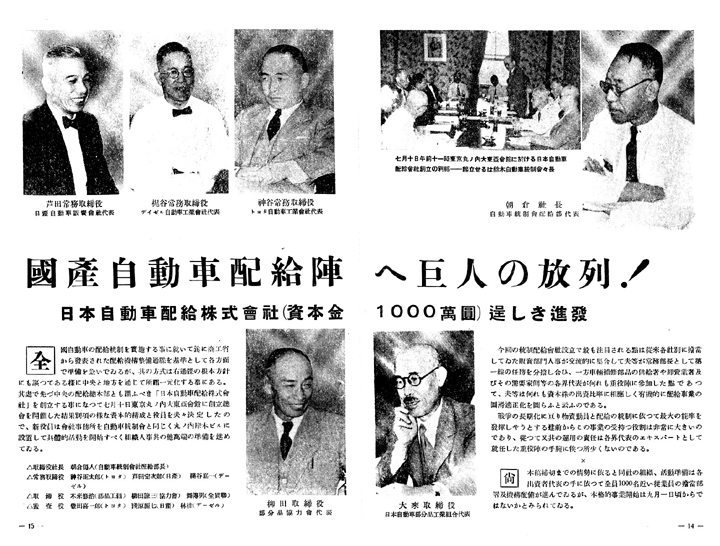Section 5. Wartime Research and Production
Item 10. The Automotive Industry Under a Controlled Economy
Control of the automobile sales industry
Under the Materials Mobilization Plan which began in 1938, truck body mounting materials were subject to an allocation system. Each dealer acted as an intermediary for truck buyers and designated body manufacturing plants and received supply of the truck body mounting materials from the Toyota Motor Materials Allocation Association, which was made up of Toyota dealers nationwide. The association was dissolved in May 1941 and Toyota Motor Co., Ltd. began directly allocating the body mounting materials.
Under the Price Control Order, explained previously, truck prices were frozen as of September 18, 1939. This was an emergency measure, however, and the Ministry of Commerce and Industry established the Vehicle Pricing Specialists Committee and announced officially fixed prices on March 24, 1941 in Ministry announcement number 241.
At the start of the 1940s, military demand accounted for the bulk of automobile sales, and demand was essentially centralized. As a result, controls on sales also developed in accordance with the intentions of users.
On July 10, 1942, the Japan Automobile Distribution Company was established as a nationwide control company under the Automobile Control Association. Regional automobile distribution companies were established in each prefecture as subsidiary organizations, and by November of that year, there were 47 companies nationwide.
The main investors in the Japan Automobile Distribution Company and the regional distribution companies were the three licensed companies under the Automotive Manufacturing Industries Law: Toyota Motor Co., Ltd., Nissan Motor Co., and Diesel Automobile Industry Company. Of the Japan Automobile Distribution Company's total capital of 10 million yen, each of the three companies contributed two million yen (for a total of 60 percent). Toyota Motor and Nissan Motor contributed equal percentages in each prefectural distribution company, while the investments of Diesel Automobile Industry Company and the Foreign Vehicle Service Part Purchasing Organization were determined based on past sales performance. In the case of the Tokyo distribution company, Toyota Motor and Nissan Motor each contributed 33 percent, Diesel Automobile contributed 10 percent, and the Foreign Vehicle Organization contributed 24 percent, (the percentage of foreign vehicles in Tokyo was the highest in Japan). Toyota-affiliated dealers and dealers affiliated with other manufacturers were consolidated into the prefectural distribution companies.
The Japan Automobile Distribution Company had exclusive control over the products of each automaker and gave preferential delivery to the military. The remaining vehicles were provided to the private sector, but many private trucks had already been requisitioned by the military, and the operation of commercial vehicles by haulers was closely supervised by the authorities. In addition, shortages of spare parts and fuel made operation of vehicles difficult, and private demand was extremely low.1



